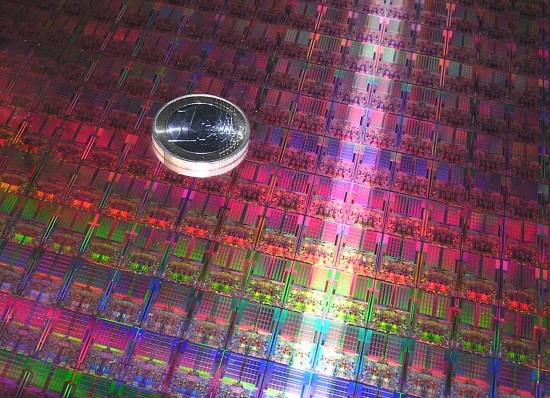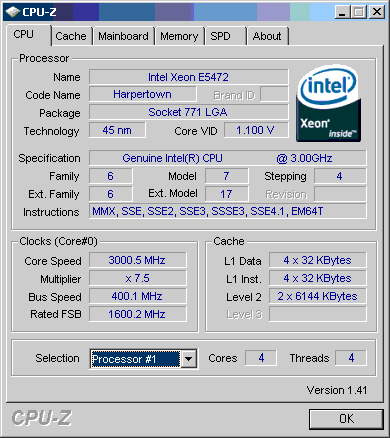AMD's 3rd generation Opteron versus Intel's 45nm Xeon: a closer look
by Johan De Gelas on November 27, 2007 6:00 AM EST- Posted in
- IT Computing
Introduction
The new Xeon 45nm (or Xeon 54xx series) arrived in the lab weeks ago, so a server CPU benchmark update is overdue. However, there is another reason we decided to write this article. When AMD launched their newest quad-core chips, we could only give you a preview of its performance - not a full review. We did not fully understand many of the performance aspects of the new AMD architecture, so we decided to delve a little deeper.
We will only focus on performance in this article, as our primary goal is to get an idea where Barcelona (AMD's quad-core), Harpertown (Intel 45nm quad-core Xeon), and Clovertown (Intel quad-core 65nm Xeon) stand. To do so, we performed a minimal profiling of each of our benchmarks and we used several new micro benchmarks that will tell you a lot more than some real world benchmarks can. If you like understanding the benchmarks out there a bit better, dig in.
The new 45 Xeon
The new 45nm Xeon 54xx series, aka "Harpertown", is still based on the Core architecture, but it has been tweaked a bit. We have already discussed those improvements in detail here and here, so we won't discuss them in detail again, but here's a quick overview:
- Faster 4-bit divider (Radix-16) instead
of 2-bit divider
- Up to 1600MHz FSB
- Shared 6MB (24-way set associative) instead 4MB L2 cache (per dual-core
die)
- Super Shuffle engine (For SSE instructions)
- Split Load Cache Enhancement
- SSE4
The Radix 16 divider is the most interesting of these improvements. Dividing involves a repetition of subtractions, tests "if-it-fits" and shifts. If you can do this with four bits at a time instead of two, this means that you can cut the number of these iterations required to get your result in half. The square root calculation is similar and also benefits from these improvements. While divisions and square roots are rather rare in common software, they have a very significant performance impact. Contrary to the more "popular" instructions, they are not pipelined and the latency of these instructions is high. For example, a floating-point multiply takes five cycles and the "Clovertown Core" architecture can finish one every two cycles thanks to pipelining. However, a floating-point division takes no less than 32 cycles and cannot be pipelined at all.

Nanotechnology is here: a core with 820 million transistors and you can fit at least two of them in one coin. (Photo by Tjerk Ameel)
Besides being an improved "Clovertown", the new Xeon is also a marvel of nanotechnology with no less than 410 million transistors on a die of only 107 mm². Two die make one quad-core Xeon 54xx. Considering that this CPU is close to behemoth CPUs like Itanium and Power 6 in SPECint performance, the new Intel is a formidable adversary for AMD's newest quad-core.

There is more than the CPU of course. The new CPU works on the old "Bensley/5000P chipset" platform, though we were not able to get it running on our P5000PSL Intel motherboard despite the fact that we applied the BIOS update that came out early this month.
There is also a new HPC/workstation platform for the Intel Xeon thanks to the Seaburg chipset, which features an improved snoop filter. Besides reducing the snoop traffic, the new chipset should also be able to extract more bandwidth out of the same FBDIMMs. The support for DDR2-800 FBDIMMs should bring another performance boost but our current test platform is only stable with DDR2-667 FBDIMMs.










43 Comments
View All Comments
Regs - Tuesday, November 27, 2007 - link
I would not expect any from vendors and wholesalers until early next year.Matter of fact I wouldn't want one until then anyhow. I would at least wait until B3 stepping.
TA152H - Tuesday, November 27, 2007 - link
Johan,From my understanding, x87 is now obsolete and not even supported in x86-64. Can you verify this? I know I had read it, from your article you state that Intel improved it, so I'm not as sure. I had assumed one of AMD's handicaps was the disproportionate, and nearly useless, x87 processing power their processors carried, but now I am not as sure. Is x87 supported in x86-64, and if not, why would Intel increase their x87 capabilities when it's clearly a deprecated technology?
JohanAnandtech - Tuesday, November 27, 2007 - link
The x87 instructions can be used in legacy mode and long mode. But it is true that Scalar SSE instructions are preferred by AMD and Intel.x87 performance as many 32 bit programs are still important (look at 3DSMAx 32 bit).
If Intel's newest Core architecture would not have improved the x87 FP it would probably have looked silly as so many 32 bit programs still use it intensively. Secondly, as you can see, things like the Radix-16 circuitry are used by both the SIMD as the x87 units.
Gholam - Tuesday, November 27, 2007 - link
Do you have any plans to benchmark Opteron vs Xeon in an ESX Server environment?DeepThought86 - Tuesday, November 27, 2007 - link
This is exactly what I was thinking of too. I want to change my mode of working to run several separate VM's, one for programming, one for Office etc and really want to know how Phenom compares to Q6600 for those uses. Well, this article looks at the server versions of those chips but for VMware the performance might be more comparable than, say, SuperPi 1M benchmarks!DeepThought86 - Tuesday, November 27, 2007 - link
I forgot to add, since Phenom would presumably also have the nested table support as Barcelona, how much performance improvement would this yield? I'd love to knowsht - Tuesday, November 27, 2007 - link
I was about to ask the same question after reading the concludingYou may feel for example that using four instances in our SPECjbb test favors AMD too much, but there is no denying that using more virtual machines on fewer physical servers is what is happening in the real world.
Since the CPUs have features that should accelerate virtualization, it would really be interesting to see how they compete there. My only addition to your request would be to add KVM as host as well (and XEN and what not as well if you care, though I really think only KVM is of interest).
JohanAnandtech - Tuesday, November 27, 2007 - link
Indeed, we are working on that. The software that we described here (http://www.anandtech.com/IT/showdoc.aspx?i=2997&am...">http://www.anandtech.com/IT/showdoc.aspx?i=2997&am... is being adapted to testing virtualized applications. We are also looking into the parameters that can really influence the results of a benchmark on a virtualized server.JohanAnandtech - Tuesday, November 27, 2007 - link
Indeed, we are working on that. The software that we described here (http://www.anandtech.com/IT/showdoc.aspx?i=2997&am...">http://www.anandtech.com/IT/showdoc.aspx?i=2997&am... is being adapted to testing virtualized applications. We are also looking into the parameters that can really influence the results of a benchmark on a virtualized server.AssBall - Tuesday, November 27, 2007 - link
Thanks, Johan.This has been one of the clearer and better proofread articles I have read here lately. It was interesting, unbiased, and insightful. I am excited to see what you get into for your next project.